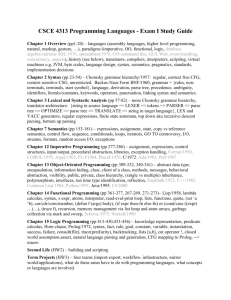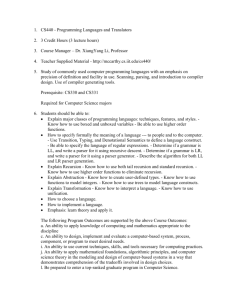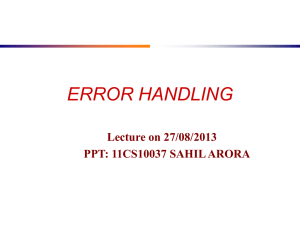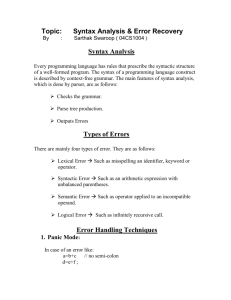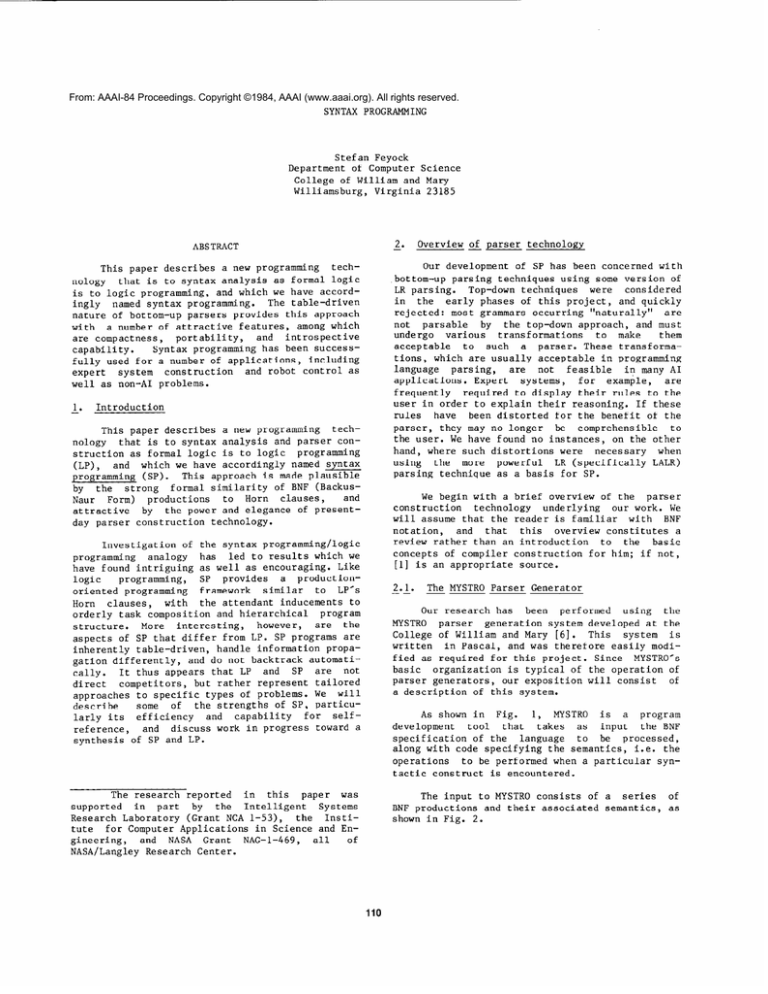
From: AAAI-84 Proceedings. Copyright ©1984, AAAI (www.aaai.org). All rights reserved.
SYNTAX
PROGRAMMING
Stefan Feyock
Department of Computer Science
College of William and Mary
Williamsburg,
Virginia 23185
ABSTRACT
This paper describes a new programming
techthat is to syntax analysis as formal logic
nology
and which we have accordis to logic programming,
The table-driven
ingly
named syntax programming.
nature of bottom-up parsers provides this approach
with
a number of attractive features, among which
and
introspective
are compactness,
portability,
Syntax programming has been successcapability.
fully used for a number of applications,
including
and robot control as
construction
expert
system
well as non-AI problems.
-1.
Introduction
This paper describes a new programming
techthat is to syntax analysis and parser connology
programming
struction as formal logic is to logic
(LP),
and which we have accordingly named syntax
This approach is made plausible
programming
(SP).
formal similarity of BNF (Backusby
the
strong
and
clauses,
Form)
productions
to Horn
Naur
attractive
by
the power and elegance of presentday parser construction
technology.
Investigation
of the syntax programming/logic
has
led to results which we
programming
analogy
have found intriguing as well as encouraging.
Like
SP provides
a productionlogic
programming,
oriented programming
framework
similar
to LP's
with
the attendant inducements
to
clauses,
Horn
program
orderly task composition
and hierarchical
however,
are the
More
interesting,
structure.
aspects of SP that differ from LP. SP programs are
handle information
propainherently table-driven,
and do not backtrack automatigation differently,
SP are
not
It thus appears that LP
and
cally.
competitors,
but rather represent tailored
direct
approaches to specific types of problems. We will
the strengths of SP, particusome
of
describe
and
capability
for
selfefficiency
larly its
and
discuss work in progress toward a
reference,
synthesis of SP and LP.
-2.
Overview
of parser
--
technology
Our development
of SP has been concerned with
bottom-up parsing techniques using some version of
LR parsing.
Top-down techniques
were
considered
in the
early phases of this project, and quickly
rejected: most grammars occurring "naturally"
are
not
parsable
by the top-down approach, and must
undergo
various
transformations
to make
them
acceptable
to
such
a parser. These transformations, which are usually acceptable in programming
language
parsing,
are
not
feasible
in many AI
applications.
Expert
systems,
for example,
are
frequently
required to display their rules to the
user in order to explain their reasoning. If these
rules
have
been distorted for the benefit of the
parser, they may no longer
be comprehensible
to
the user. We have found no instances, on the other
hand, where such distortions were
necessary
when
using
the
more
powerful
LR (specifically
LALR)
parsing technique as a basis for SP.
We begin with a brief overview of the parser
construction
technology
underlying
our work. We
will assume that the reader is familiar
with
BNF
notation,
and
that
this
overview constitutes
a
review rather than an introduction
to
the
basic
concepts of compiler construction
for him; if not,
[l] is an appropriate
source.
2.1.
--
The MYSTRO
---
Parser
Generator
Our research has
been
performed
using
the
MYSTRO
parser
generation system developed at the
College of William and Mary [6]. This
system
is
written
in Pascal, and was therefore easily modified as required for this project. Since
MYSTRO's
basic
organization
is typical of the operation of
parser generators,
our exposition will consist
of
a description
of this system.
As shown in Fig.
1, MYSTRO
is a program
development
tool
that
takes
as
input
the BNF
specification
of the
language
to
be processed,
along with code specifying the semantics, i.e. the
operations
to be performed when a particular syntactic construct is encountered.
The input to MYSTRO consists of a series
BNF productions
and their associated semantics,
shown in Fig. 2.
of
as
2.2.
--
if no
MYSTRO
analyzes
this
grammar
and,
are
detected,
errors
produces
a set
of parse
utilized
by
the
tables which
are
subsequently
to process its input. This parser is conparser
structed
by MYSTRO
by
inserting
declarations,
scanner
routines, and the semantics for each production into a preexisting
skeleton
parser
program.
+------grammar
parser
skeleton-->
---- -- ---- -+
MYSTRO
parser generator
-->
It should be noted
that
the disambiguating
the role of metarules: when more
predicates
play
than one rule "fires", these predicates
are
used
They
have access to the
to establish
priority.
parse
including
the
entire parsing environment,
present
parse state, and the parse tables
stack,
extensive
themselves, and thus can be used to do
introspection
if desired.
1
+------------------+
I
parse
tables
+---a-----+
user
interaction
<-->
1 parser 1
+---------+
-3.
The operation
Fig.
*
*
*
*
*
Optimizer
Expert
--
Example
System
1
It is important to note that syntax
programming, like logic programming,
is a general-purpose
than
an
software construction
methodology
rather
Like
LP, however, SP appears
AI-specific
tool.
particularly
I suited
to the
requirements
of
a
Our
first example is
of AI
problems.
variety
system
accordingly
the SP version
of an expert
Rogers
at
currently
under
development
by J.
NASA/Langley
Research Center. It represents a consystem
to be sent to prospective
users
sultation
Program
of the ADS-l General Purpose Optimization
a large package of FORTRAN-based
optimizer
[Ill,
programs for structural optimization.
To use
this
package
the user must make a number of decisions
the
nature
of his
optimization
that depend on
he must
decide on the
problem.
In particular,
of one-dimensional
strategy, optimizer, and type
to be used.
These decisions can require
search
3 is an
considerable
expertise;
the SP of Fig.
excerpt
from
an
SP expert system that provides
deciconsultation
to aid the user in making this
and associated
Fig.
Programming
3.1.
--
<declaration>
::= DECLARE <id> INTEGER;
* Here come the semantics,
* denoted by a blank in column 1.
<declaration>.location
:= get-free-word;
* The notation
<symbol>.attribute
* occurring in the semantics is translated
* by MYSTRO into a semantics stack reference:
* sem stack[stack ptr].location
:= get free word;
<declaration>.type
:= integer;
<declaration>.value
:= <id>.value;
BNF Production
A Syntax
--
of MYSTRO
Lines with * in column 1 are comments.
A < in column 1 signifies the beginning
of the left-hand side (lhs)
of a BNF production.
Typical
Resolution
It frequently happens that the
grammar
that
is given to the parser generator is not acceptable
(MYSTRO
to the parsing scheme used by the parser
MYSTRO allows the
is a LALR
narser generator).
use of disambiguating
predicates to deal with such
When
the
parser reaches a parse
contingencies.
contable entry corresponding
to a shift/reduce
is always to shift; this has
the
decision
flict
encountering
a
Upon
worked well
in practice.
prediconflict, the disambiguating
reduce/reduce
cates associated with the conflicting
productions
are
evaluated
in
order, and the first one whose
predicate evaluates to true is used. (If none
of
the predicates evaluates to true, the last production in sequence, which must not have a predicate
associated with it, is used.) The robot controller
given in the Appendix makes extensive use of such
disambiguating
predicates,
which are denoted by a
/ in column 1.
text
An LR parser
reads
and
stacks
input
until the parse stack contains the right-hand side
(rhs) of the appropriate
production,
as determined
the
parse tables.
At that time the semantics
by
associated with that production are executed.
The
semantics
stack
referred
to above is a parallel
stack to the parse stack. The semantics stack elements are typically records containing a field for
input
Ambiguity
sion.
semantics
2
This example serves to illustrate a number of
regarding
syntax programming.
Perhaps the
points
simplicity
of this
most obvious is the
extreme
While
many of the productions
that conprogram.
that
stitute the actual system have been omitted,
system differs from our excerpt only in the number
this
It should be emphasized that
of productions.
system is an actual application
that is to be sent
out to ADS-l users, not a contrived toy problem.
such
as location,
each item of interest,
type9
value, etc.
Upon completion of the semantics code
the rhs on the parse stack is replaced by the
lhs
of the production.
111
two of the fundamental
advantages of syntax
programs:
compactness and portability.
If an expert
consultant system is to be sent to a user
community accustomed to FORTRAN packages, it is not usually feasible to write the expert system in,
say,
INTERLISP
or
one of the expert system generators
based on it, and then send the
resulting
system,
which
is apt to be quite large, to the user along
with the blythe directive "Just put this system up
on your
machine
and
you'll be all set." On the
other
hand,
the
arguments
against
writing
an
ad hoc
in FORTRAN or other algoexpert
system
rithmic languages are well known.
It is interesting
to note that
much
of the
simplicity results from the fact that an LR parser
relevant
maintains a large amount of information
in its states and
automatically
problem
to the
parse tables. Consider, for example, the item
set
in
Fig. 4.
to state 3, depicted
corresponding
(Readers not
familiar
with
item
sets: back
to
[l]!) As
can
be seen, this state automatically
"problem
is gradient"
is
records the fact that
known, as well as indicating clearly the facts yet
engendered
automatically
to be established.
This
knowledge maintainance
facility explains the scarcity of explicit semantics associated with most of
the productions.
Syntax programs bypass both sets of difficulties in an elegant manner.
As depicted in Fig. 1,
of
the output of the parser generator
is a set
The s econd import ant point of this example is
typical of applic ations that require
that
it is
? AMBIGUOUS+
XREF- MAXIMA- SCAN- ECHO+
<answer> ::= <optimizer choice>
writeln(' END OF SESSTON. ');
<optimizer choice> ::= <strat:2,opt:2,ld_search:4>
* MYSTRO attaches no special significance
to most special characters
* such as underscore,
comma, or colon.
writeln('
STRATEGY IS 2, OPTIMIZER IS 2, AND lD-SEARCH IS 4. ')
*
<optimizer-choice>
::= <strat:2,opt:4,ld
search:4>
writeln(' STRATEGY IS 2, OPTIMIZER IS 4, AND lD-SEARCH
*
*
*
--- other
(*** etc.
<optimizer - choice>
<strat:2,opt:2,ld_search:4>
<strat:2>
::=
<strat:2>
::= <?ask,problem,is,lst-order>
alternatives
<opt:2>
IS 4. ')
not shown
***)
<search:4>
<strat:2 - or - 4>
<strat:2 or 4> ::=
+ <?ask';prcblem,is,unconstrained>
+ <?ask,problem,has,more,than,5O,design,variables>
+ <?ask,problem,is,gradient>
+ <?ask,no,feasible,starting,points,can,be,found>
* + in column 1 denotes continuation
of production
.
,
*
(***
etc.
---
Typical
remaining
productions
Productions
not shown
from SP Optimizer
Fig.
State 3 <?ask,problem,is,gradient>
shift [ 71 <opt:3>
::=
<?ask,problem,is,gradient>
shift [ 91 <opt:5>
**=
<?ask,problem,is,g;adient>
Portion
***)
Expert
System
3
. <?ask,problem,is,large,or,very,large>
. <?ask,problem,is,medium,or,small>
. . .. .. .
of Typical
Fig.
4
Item Set
tables,
are plugged into a parser skeleton
which
parser
that
embodies
the
to produce a running
expert
system.
This
parser
skeleton
can be in
whatever language is desired; we currently have
a
parser
skeleton
in Pascal, one in LISP, and are
these
Moreover,
working on a FORTRAN
version.
are
quite
compact: the Pascal
parser
skeletons
LISP
skeleton has fewer than 800 lines, while the
skeleton is less than half as large.
3.2.
--
Turning
--
a ---Parser
into
an SP Processor
Argument
passing
~-~-
and control
flow
We now turn to a comparison of two
important
aspects
in which SP and LP differ: argument passing and flow of control.
Information in LP is propagated
the
"parse
tree", i.e. the tree of
given
point
in
the
computation,
instantiation
of
argument variables
unification.
We assume the reader is
this
mechanism;
if not, [3] and [7]
dard references.
up
and
down
subgoals at a
by means
of
as forced by
familiar with
are the stan-
aspect
We now turn to an important technical
Consider the production
of this example.
<strat:2>
::=
<?ask,problem,is,lst-order>
-4.
<strat:2 - or - 4>
conRecall that entities enclosed in < -- > are
to be single (nonterminal
or pseudotermisidered
length.
The
nal) symbols, regardless
of their
symbol
<strat:2 or 4> is a nonterminal
defined on
The
the right-hand sTdeof
a separate production.
symbol
<?ask,problem,is,lst-order>,
on the other
hand, is a pseudoterminal
of a kind unique to
SP.
is part of the parser skeleton
The
scanner
that
has been modified to give
pseudoterminals
beginspecial
sequence "<?"
ning
with
the
character
to be
are deemed
treatment: such pseudoterminals
to the (boolean) procedure named
procedure
calls
The pseudoterminal
after the "?".
We have experimented
with two
approaches
to
argument
manipulation
and information
propagation
in connection with SP.
One is the methodology
we
have described in our overview of parsing technolproduc%Y 9 which involves associating with each
tion
certain
semantic
actions
which consist of
essentially
unrestricted
code
written
in
the
language
of
the
parser
(Pascal
or LISP in our
case) performing
arbitrary
manipulat ion
of
the
environment
and
database at the time a reduction
is pending.
This
information
propagation
scheme
has
several
disadvantages.
One
of
these
is the
aforementioned
lack of discipline:
the programming
environment
is that of the semantics language. For
example, if the semantics language is Pascal,
the
semantics
consist of essentially
arbitrary Pascal
code.
<?ask,problem,is,lst-order>
is thus handled
procedure call
by the scanner
ask('problem
as if it
were
the
is lst-order');
The procedure ask simply queries the user
regardin this case it would geninpuKtring;
ing its
erate
IS IT TRUE THAT
problem
is lst-order
?
If the user's response is "yes", the effect is as
if the pseudoterminal
had indeed been encountered
accordas head-of-input,
and the parser proceeds
ingly;
if not, the scanner seeks to establish the
presence (truth) of alternate pseudoterminals,
as
directed
by
its tables.
The pseudoterminals
are
read in as part of these tables.
The parser/scanner
modification
we have
just
It effectively
described
is critical
to
SP.
transforms the parsing environment
from
input
text --> scanner
--> tokens
--> parser
base <--> scanner
--> tokens
--> parser
to
data
It is this generalization
of the scanning
mechanthat transforms a parser from a language proism
processing device to a powerful general-purpose
gramming tool.
A second disadvantage
lies in the
fact
that
information
residing
in the semantics of symbols
on the parse stack below the left-hand side of the
current production
is not accessible in an orderly
fashion; in other words, all attributes
are
synthesized attributes.
4.1.
--
-Affix
Grammars
These disadvantages
have led us
to investigate
the
feasibilty of using affix grammars
[9],
which promised to provide
a highly
disciplined
information
propagation
method
that
has strong
formal similarity to the arguments used for information
propagation
in
logic
programs.
This
approach has proven to be highly
productive,
and
has
been
used
in a number of SP programs. The
Appendix contains an SP program with
affix
arguments
that
implements a robot controller similar
to the one presented in [lo]. A
similar
program
has been used (after preprocessing
as described in
[9]> to
control
one
of
the
robot
arms
in
NASA/Langley
Research Center's Intelligent
Systems
Research Laboratory.
The theory underlying
LR parsing
of
affix
grammars
is
far too extensive to present in this
space; we must confine ourselves to a very
brief
overview.
Consider the production
<puton>!object,support
::=
<getspace>!object,support
<putat>!object,place
-place
is entered,
and that the database
consists
of
mother(ann,john),
father(harry,john),
father(harry,jane)
(in that order). Then the subgoal parent(ann,john)
will
be
tried
first,
but will
have
to
be
retracted, since parent(ann,jane)
cannot be established.
An
LR
parser-driver
SP program cannot
perform such a backup. A query such as this
would
be handled by expressing it in terms of a database
query.
In relational terms, the
given
query
is
equivalent to the retrieval (in an idealized relational query language)
4.2. ~-Control Flow and Backtracking -in SP
-Since, like most logic programmers,
we had become
accustomed to thinking of backtracking
as a way of
life, it was with some surprise that we noted that
SP's
lack
of backtracking
caused no difficulties
in the problems we attacked. This
was
true
even
though
these
problems
had
not
been chosen for
their lack of backtracking
requirements;
rather,
they were research problems that were "in the air"
at NASA/Langley
Research Center. Nonetheless
there
are many
problems for which a backtracking
solution is natural, and it is desirable for
SP programs to be able cope with them.
parent john intersect parent jane
where-parent
john = {z
father(z,john)
union {z
mother(z,john)
and
parent - jane = (2
father(z,jane>
union {z 1 mother(z,jane)
A retrieval such as this (or its equivalent
in the
semantics
language)
would then appear as part of
the semantics of the SP program.
We
have
found
that it is frequently possible to eliminate backup
by means of such a transformation.
-5.
4.3.
Semantic Backtracking
-One obvious solution lies in the
fact
that
the
semantics
of an
SP program can contain calls to
arbitrary procedures written in or callable
from
the
language
in which the parser is written. As
indicated, we have implemented
a parser
skeleton
in LISP,
as well as one in Pascal that can call
Lispkit
LISP
code
[5].
Thus
arbitrary
LISP,
Lispkit,
or Pascal
functions can be invoked, in
particular functions
that
implement
Prolog-like
capabilities.
PiL [8] provides such a function in
(full) LISP, while [2] describes a purely applicative version suitable for a Lispkit LISP implementation.
By this means backtracking
can
be confined
to situations
where
it is necessary for
searching the solution space, and need not be used
in roles which are more aptly filled by other control structures.
Discussion
Having presented the
underlying
syntax
concepts
programming,
we
now examine some of the implications of this method of programming.
These
derive
largely
from the fact that the behavior of an LRparser based syntax program is driven by the parse
tables
it reads in. We have already discussed the
fact that SP programs thus inherit the compactness
and high speed exhibited by LR parsers in general.
We have not yet emphasized,
however,
one
of
the
most important implications
of this fact: since an
SP program's behavior is determined by
its
parse
tables, and since these parse tables can form part
of the data base accesssed by the program, any
SP
program has the potential for extensive introspection into its own
operation.
In particular
it
appears
straightforward
to provide the user with
the capability to to ask questions such as " what
is
your
present
state?"
and
"what
are
the
presently legal inputs?", and have
the
responses
generated
automatically
on the basis of the parse
tables and parse stack.
([4] discusses the implementation
of
a similar capability for transition
diagrams.) We consider this capability to be
one
of
the most exciting consequences
of our method,
and are actively pursuing this aspect of SP.
Transforming
Backtracking
into
4.4.
Database
-Queries
There is a further class of situations which
are
implemented
by means
of backtracking
in LP, but
which turn
out
to be
easily
implementable
as
straightforward
database
searches. Consider this
example:
sibling(x,y)
:- parent(z,x),parent(z,y).
/* sibling here actually refers to
sibling or half-sibling
*/
parent(z,x)
:- mother(z,x).
parent(z,x)
:- father(z,x).
Suppose
}
}
}
}
Explanation
of reasoning process
5.1.
-The ability to explain its reasoning to the
user
feature
of expert systems.
is an indispensable
SP-based expert systems achieve this
effect
very
neatly:
since their mode of operation is based on
parsing, it is trivial for them to display
their
parse
tree,
which
is a representation
of their
"reasoning process" so far.
the query
sibling(john,jane)?
114
-6.
Diagram-based
CAI/HELP
4. Feyock, S., Transition
Systems, International
Journal of Man-Machine
Studies 9, pp. 399-413, 1977.
Conclusion
Syntax programming
has been successfully
applied
addition to those
in
to a number
of problems
include
These
problems
presented in this paper.
problem, a graph manipulator,
the
Tower-of-Hanoi
effector
robot
end
an expert system to diagnose
as well as a NASA-funded
project to
malfunctions,
apply SP to the construction
of an in-flight pilot
to provide malfunction
consultation.
aid
system
currently
in progress
and
This last project is
typifies
the sort of problem for which SP is well
of rule-based expert syssuited: the construction
terns that feature the compact size and high executable-driven
LR
parsing
tion speed inherent
in
technology.
Henderson,
P,
5.
Prentice-Hall,
1980.
7.
Kowalski,
North-Holland,
R., P-P
Logic
1979.
8. Wallace, R., An
(Prolog
in LISP),
29-32, July 1983.
Easy
SIGART
for
of Compiler
-
10. Winston,
P.,
Wesley, 1981.
2. Carlsson, M., On Implementing
Prolog in Functional
Programming,
Proc.
of
the 1984 International Symposium on Logic Programming,
pp. 154-159
Atlantic City, NJ, February 1984.
Programming
and
B.
Horn,
LISP,
Addison-
ADS-l:
A
New
11. Vanderplaats,
G.,
et
al.,
General-Purpose
Optimization
Program, Proceedings
Strucof the AIAA/ASME/ASCE/AHS
24th Structures,
Dynamics,
and Materials
Conference,
pp.
tural
117-123, Lake Tahoe, Nevada, May 1983.
-in
::= <readconds>^object,support
(apop 2) ; clear the affix stack
* This syntax program uses the LISP
*
<puton> b!obje ct , support
<goal>
<eof>
s keleton.
<readconds>^object,support
::=
(terpri) (print "object to move?,")
(terpri) (print "support?,")
(apush
*
<puton>!object,support
::=
<getspace>!object,support
"place
(terpri)
(apush ( read)
(read) > (terp ri
<putat>! objet
t, place
(apop 3) ;
<putat>!object,place
::=
<grasp>!object
<moveobject>!object,place
<ungrasp>!object
(apop 3) ;
*
***** Several productions
have been omitted here for brevity
*
<notsupported>
::=
* epsilon productions
often cause ambiguity
(usually intentional)
! (! notsupported)
* If (! notsupported)
returns true, this production fires.
*****
*****
Solving,
Implementation
of PiL
Newsletter,
No. 85, pp.
Appendix
*
Problem
Gram9. Watt, D. The Parsing Problem for Affix
mars, Acta Informatica,
v. 8, pp. l-20 (1977).
and J. Ullman, Principles
Addison-Wesley,
1977.
3. Clocksin, W., and C. Mellish,
Prolog, Springer-Verlag,
1981.
Programming,
Parser
6. Noonan, R., and R. Collins, The MYSTRO
Generator
PARGEN
User's Manual, Internal Report,
Dept. of Computer Science, College of William
and
Mary, Willimamsburg,
VA.
REFERENCES
1. Aho, A.,
Construction,
Functional
Remaining productions
have been
Complete program avai lable upon
115
omitted
request
for brevity.


